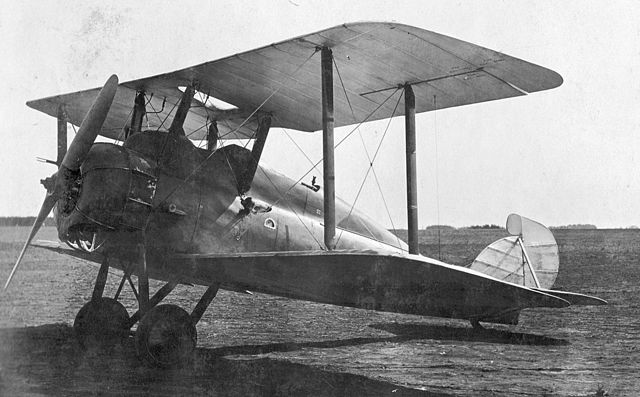Top Qs
Timeline
Chat
Perspective
Parnall Panther
From Wikipedia, the free encyclopedia
Remove ads
The Parnall Panther was a British carrier-based, spotter and reconnaissance aircraft designed and developed by Parnall and Sons in the latter years of the First World War, continuing in service until 1926. A total of 150 Panthers were built by Bristol Aeroplane Company since after the end of the war, Parnall had stopped aircraft manufacture.
Remove ads
Development
The Parnall Panther was designed by Harold Bolas, who had joined Parnall and Sons after leaving the Admiralty Air Department, where he had served as deputy chief designer under Harris Booth.[1] It was planned to meet the requirements of Admiralty Specification N.2A for a two-seat reconnaissance aircraft capable of operating from aircraft carriers. The first prototype (serial N91) flew in 1917, with a further five prototypes being produced.[2]
Remove ads
Design
The Panther was a wooden, single-bay biplane, which, unusually for the time, was fitted with a birch plywood monocoque fuselage which could be folded for shipboard storage, the fuselage being hinged aft of the observer's cockpit.[2] The pilot and observer were seated in individual cockpits in the deep fuselage, this giving a good view for landing but restricting access to the pilot's cockpit. Inflatable flotation airbags were fitted beneath the wings in case the aircraft ditched into the sea, with a hydrovane in front of the undercarriage, to stop the aircraft from nosing over.
Remove ads
Operational history
After evaluation, an order for 300 Panthers was placed with Parnall in 1918 and then reduced to 150 following the end of the war. Parnall's owners, W & T Avery, rejected this reduction in the order and it was transferred to the Bristol Aeroplane Company, the order being completed between 1919 and 1920.[3] The Panther served with Spotter Reconnaissance Flights aboard the aircraft carriers HMS Argus and Hermes. While the Panthers handled well in the air, the elderly Bentley engines proved unreliable and the system of longitudinal arrestor wires in use aboard British aircraft carriers, was unsatisfactory, resulting in many accidents.[2] Panthers continued in service with the Fleet Air Arm until 1926, being replaced by the Fairey IIID.[4] Two Panthers were sold to the US Navy in 1920.[3][5][6] Twelve Panthers were sold to the Imperial Japanese Navy in 1921–22.[7]
Operators

Specifications
Data from British Naval Aircraft since 1912 [8]
General characteristics
- Crew: 2
- Length: 24 ft 11 in (7.59 m) (14 ft 6 in (4 m) folded)
- Wingspan: 29 ft 6 in (8.99 m)
- Height: 10 ft 6 in (3.20 m)
- Wing area: 336 sq ft (31.2 m2)
- Empty weight: 1,328 lb (602 kg)
- Max takeoff weight: 2,595 lb (1,177 kg)
- Powerplant: 1 × Bentley BR2 9-cylinder air-cooled rotary piston engine, 230 hp (170 kW)
- Propellers: 2-bladed fixed-pitch propeller
Performance
- Maximum speed: 108.5 mph (174.6 km/h, 94.3 kn) at 6,500 ft (1,981 m)
- Range: 480 mi (770 km, 420 nmi) [9]
- Endurance: 4 hours 30 minutes
- Service ceiling: 14,500 ft (4,400 m)
- Time to altitude: 2,000 ft (610 m) in 2 minutes 20 seconds
Armament
Remove ads
See also
Footnotes
Bibliography
External links
Wikiwand - on
Seamless Wikipedia browsing. On steroids.
Remove ads

